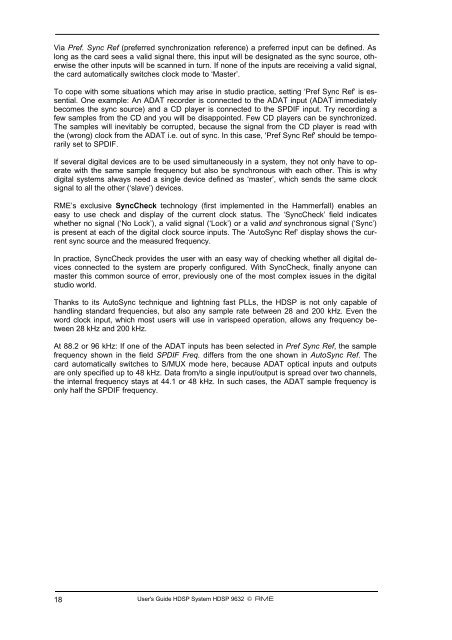Create successful ePaper yourself
Turn your PDF publications into a flip-book with our unique Google optimized e-Paper software.
Via Pref. Sync Ref (preferred synchronization reference) a preferred input can be defined. As<br />
long as the card sees a valid signal there, this input will be designated as the sync source, otherwise<br />
the other inputs will be scanned in turn. If none of the inputs are receiving a valid signal,<br />
the card automatically switches clock mode to ‘Master’.<br />
To cope with some situations which may arise in studio practice, setting ‘Pref Sync Ref’ is essential.<br />
One example: An ADAT recorder is connected to the ADAT input (ADAT immediately<br />
becomes the sync source) and a CD player is connected to the SPDIF input. Try recording a<br />
few samples from the CD and you will be disappointed. Few CD players can be synchronized.<br />
The samples will inevitably be corrupted, because the signal from the CD player is read with<br />
the (wrong) clock from the ADAT i.e. out of sync. In this case, 'Pref Sync Ref' should be temporarily<br />
set to SPDIF.<br />
If several digital devices are to be used simultaneously in a system, they not only have to operate<br />
with the same sample frequency but also be synchronous with each other. This is why<br />
digital systems always need a single device defined as ‘master’, which sends the same clock<br />
signal to all the other (‘slave’) devices.<br />
<strong>RME</strong>’s exclusive SyncCheck technology (first implemented in the Hammerfall) enables an<br />
easy to use check and display of the current clock status. The ‘SyncCheck’ field indicates<br />
whether no signal (‘No Lock’), a valid signal (‘Lock’) or a valid and synchronous signal (‘Sync’)<br />
is present at each of the digital clock source inputs. The ‘AutoSync Ref’ display shows the current<br />
sync source and the measured frequency.<br />
In practice, SyncCheck provides the user with an easy way of checking whether all digital devices<br />
connected to the system are properly configured. With SyncCheck, finally anyone can<br />
master this common source of error, previously one of the most complex issues in the digital<br />
studio world.<br />
Thanks to its AutoSync technique and lightning fast PLLs, the H<strong>DSP</strong> is not only capable of<br />
handling standard frequencies, but also any sample rate between 28 and 200 kHz. Even the<br />
word clock input, which most users will use in varispeed operation, allows any frequency between<br />
28 kHz and 200 kHz.<br />
At 88.2 or 96 kHz: If one of the ADAT inputs has been selected in Pref Sync Ref, the sample<br />
frequency shown in the field SPDIF Freq. differs from the one shown in AutoSync Ref. The<br />
card automatically switches to S/MUX mode here, because ADAT optical inputs and outputs<br />
are only specified up to 48 kHz. Data from/to a single input/output is spread over two channels,<br />
the internal frequency stays at 44.1 or 48 kHz. In such cases, the ADAT sample frequency is<br />
only half the SPDIF frequency.<br />
18<br />
User's Guide H<strong>DSP</strong> <strong>System</strong> H<strong>DSP</strong> <strong>9632</strong> © <strong>RME</strong>
















